Articles
Kimball And Schulian Talk Fightwriting, Part I
The Library of America interviews
George Kimball and John Schulian about
At the Fights: American Writers on Boxing
In connection with the publication in March 2011 of At the Fights: American Writers on Boxing, edited by George Kimball and John Schulian, Rich Kelley conducted this exclusive interview for The Library of America e-Newsletter. Sign up for the free monthly e-Newsletter at www.loa.org.In his preface to At the Fights Colum McCann makes a persuasive case that boxing and writing are metaphorical twins: the ring, the page; the punch, the word; the bell, the deadline. What is it about boxing that has inspired so much great writing?
Schulian: There’s an almost electrical charge to boxing that separates it from every other sport. Boxing is elemental, visceral. It’s the closest thing to combat that most writers ever see. One on one. Primitive.
Savage. And yet beautiful and ennobling and capable of inspiring a kind of sweat-stained poetry. It’s not a humane sport by any stretch of the imagination, but it is wonderfully human, and that factors into what is written about it. The most quotable, accessible, big-hearted athletes I’ve ever covered are prizefighters. Doesn’t matter whether they’re choirboys or ex-cons. They all talk, they all share pieces of their lives that athletes in other sports would never reveal. The important thing to remember, though, is that this is life in microcosm. It’s beautiful, messy, profane, funny, sad, cutthroat, brutal—and yet heroes rise from it even if their hands aren’t always raised in victory. When I think of what I’ve written about boxing, so
much of it feels like noir fiction, and yet I was there, I saw it happen. And if I hadn’t seen it, when I’d read somebody’s account of it, I’d want a taste the next time a big fight came along. Because, as every writer who’s been there will tell you, there’s nothing in all of sports that compares.
At the Fights kicks off with Jack London’s account of the epic 1910 battle between Jack Johnson, the first African American heavyweight, and James Jeffries, the fighter London dubbed the “Great White Hope.” Does this event mark the beginning of the long love affair between writing and boxing? Was this when boxing came into its own—or was it just when writers started to pay attention?
Kimball: Yes and no. Johnson–Jeffries wasn’t even the first heavyweight title fight London covered. (He’d been, almost by accident, in Australia when Johnson won the title from Tommy Burns.) Fights had been covered from the days of John L. Sullivan. Nelly Bly, the most popular newspaperwoman of her day, had written a profile of Sullivan. But, charged by the racial angle, the fight in Reno was the first full-fledged media circus. Virtually every newspaper in the country was represented, often by celebrity correspondents like London and Rex Beach. Western Union transmitted more copy from that fight than for any single event until Lindbergh landed in Paris seventeen years later. Not only was boxing legitimized as a subject worthy of front-page news, but many reputations were forged by the coverage of that event. Within a year New York had legalized boxing (albeit temporarily), and men like Damon Runyon and Gene Fowler and W. O. McGeehan came to New York to cover it.
Schulian: Being the boxing historian he is, George answered this question admirably. I would suggest, however, that boxing writing didn’t really flourish until after World War II. Before then, great writers could be found at ringside, from literary types like H. L. Mencken and Richard Wright to upwardly mobile newspapermen like Heywood Broun and Paul Gallico. But too many of the era’s sports pages were filled by hacks and drunks and guys waiting for a bribe from the local fight promoter. That changed when key post-war sports editors— Stanley Woodward at the New York Herald Tribune, Larry Merchant at the Philadelphia Daily News, Jack Mann at Long Island’s Newsday—began putting a premium on trenchant reporting, stylish writing, and irreverent wit. The best of the writers who were turned loose in this uprising became legends: Red Smith, Jimmy Cannon, W. C. Heinz, John Lardner. Soon enough, in 1954, the young writers who embraced those giants as role models had not just newspapers to work for but a glossy magazine called Sports Illustrated, and SI became a bastion of great fight writing by Budd Schulberg, Mark Kram, Pat Putnam, Bill Nack, and Richard Hoffer, to name just a few. This surge in artistry was helped along by the stunning parade of fighters they could write about, from Joe Louis, Sugar Ray Robinson, and Archie Moore to Muhammad Ali, Sugar Ray Leonard, Thomas Hearns and Roberto Duran. And Joe Frazier. And George Foreman. And Larry Holmes. And Mike Tyson. And . . . you get the picture. For a fifty-year stretch, a wonderful and amazing thing happened: there was fight writing every bit as great as the fighting itself. The appeal of writing about boxing clearly extends far beyond sportswriters. At the Fights includes pieces by H. L. Mencken, Sherwood Anderson, Richard Wright, James Baldwin, Budd Schulberg, Norman Mailer, Gay Talese, Pete Hamill, Joyce Carol Oates, David Remnick—it’s as if there’s an unofficial competition among writers for the title of greatest heavyweight boxing writer—or at least the sense that to be a great writer you have to tackle boxing. Who gets to be in the title matchup?
Kimball: That’s not a question to which I’d have given much thought, but since you’ve asked it, my visceral reaction is that the title would go to Liebling, with everybody else left scrambling for second place. If you’d asked them, Mailer and Hemingway would probably each have claimed he belonged in the finals. (Hemingway did write some fine boxing fiction. He also wrote some decent boxing articles and columns for the Toronto Star from Paris in the early 20s, but in the end we felt none of them measured up to the high standard we’d set for At the Fights.) We excerpted Mailer’s The Fight, but the truth of the matter is that Budd Schulberg knew and truly understood more about boxing than either one of them, and moreover, he was 2–0 in fistfights with Mailer and Hemingway. I don’t think any of the others you mention would have considered themselves contenders for your title, simply because writing about boxing was neither their primary focus or aspiration. In fact, some of the pieces by those writers worked as well as they did precisely because of the presumption of the author’s naiveté: After laying bare their lack of sophistication on the subject, they allow the reader to share in their process of illumination. This is certainly true for Sherwood Anderson (“Brown Bomber”) as he tries to figure out what all the fuss is about with this guy Joe Louis, and as Harold Conrad observed of the James Baldwin who came to Chicago to cover the Liston–Patterson fight, “he doesn’t know a left hook from a kick in the ass.” As much as she’s written about the sport, I doubt that Joyce Carol Oates has ever for a moment considered herself a boxing pundit, but she’s smart enough to ask the right questions.
Schulian: There’s no question that Mailer is the biggest name in the book. And there’s no denying that he could write up a storm. His prose is incandescent. But that doesn’t make Mailer the champ. If you polled the other contenders for the title, you’d soon discover who stands atop the mountain: A. J. Liebling. He brought wisdom, laughter, a keen eye, and a thoroughly charming prose style to his boxing writing, and he left behind an unequaled body of work. True, he filed the bulk of his dispatches for a weekly, The New Yorker, but if the legend that he was a fast and effortless writer is true, he would have been just as readable working against an AM newspaper deadline. Just thinking about Liebling makes me smile, because my head fills with the music of his prose and the magic he found in the sport he called the Sweet Science.
In January 2003 Sports Illustrated ranked A. J. Liebling’s The Sweet Science #1 of the 100 best sports books of all time, calling Liebling “pound for pound the top boxing writer of all time.” You include two Liebling pieces in the book. What made Liebling so great—and do we see his influence in any of the other writers in the book?
Kimball: The wonder shouldn’t be that there are two Liebling pieces, but that there are only two. (He and Schulberg have the only double-barreled entries in the anthology.) If I’d been compiling that list, The Sweet Science would be No.1, and A Neutral Corner, Liebling’s other collection of (mostly) New Yorker pieces No. 2. Putting At the Fights together was a painstaking, year-long process that was often like a jigsaw puzzle, because sometimes the decision to include a particular piece would, due to subject matter or tone or approach, displace others. John and I made a conscious decision early on to hold Liebling in reserve. We knew whichever of his pieces we wound up using, they were going to work. Our initial inclination, for instance, had been to include Liebling’s terrific account of his visit to Sonny Liston’s training camp, but if we’d used that we probably wouldn’t have been able to include Joe Flaherty’s wonderful “Amen to Sonny,” and if we hadn’t used Liebling’s “Kearns by a Knockout” we’d probably have had to find two more pieces to adequately address Doc Kearns and Sugar Ray Robinson. It was sometimes like playing Whack-A-Mole, because every time you’d hammer one down, three more would pop up somewhere else. But in that respect Liebling was a constant security blanket, our wild-card, because of our unshaken confidence that whatever we wound up using was going to be great. Anyone who has written about boxing for the last fifty years owes a great debt of gratitude to Joe Liebling, so yes, his influence has been both pervasive and profound, but woe be unto the conscious imitator. Any writer who sets out trying to write his own “Liebling piece”—and there have been a few—is inexorably doomed to fall flat on his face.
Schulian: Why was Liebling so great? Because he could make you laugh by writing about a fighter who was “so hairy that when knocked down he looks like a rug.” Because he could find the nobility in Archie Moore’s fruitless quest to knock out Rocky Marciano: “Would Ahab have been content merely to go the distance with the White Whale?” Because I could read him and think there was no higher calling than to write about boxing. And I know there were, and are, others like me. Five decades’ worth, if my math is right. I hear echoes of Liebling when I read Mark Kram and Bill Nack and Richard Hoffer, each very much a stylist in the great man’s tradition, each capable of reaching heights of brilliance. But the echoes are ultimately still that and nothing more, for there could be only one Liebling. He was the truth and the light.
Over the past hundred years boxing has gone through several “ages” — and perhaps more than one “golden age.” For those unfamiliar with the history of boxing would you be willing to briefly characterize the different ages—and how the pieces in the book map to those times?
Schulian: Since Liebling seems to be the connective tissue here, I’m tempted to quote him as I try to make sense of boxing’s various ages. The paragraph I have in mind begins with Liebling saying, “It is through Jack O’Brien, the Arbiter Elegantiarum Philadelphiae, that I trace my rapport with the historic past through the laying on of hands. He hit me, for pedagogical example, and he had been hit by the great Bob Fitzsimmons, from whom he won the light-heavyweight title in 1906.” Liebling goes on to list fighters who have crossed each other’s paths and walloped each other’s jaws all the way back to the early Victorians. “The Sweet Science,” he writes, “is joined onto the past like a man’s arm to his shoulder.”
So that takes us up to Jack Johnson, the great scorned heavyweight who ushered us into the early twentieth century. Not to diminish the fighters who came before Joe Louis, but they couldn’t match him in either ring talent or celebrity candlepower. And I’m talking about great, great fighters, guys whose campaigns for championships couldn’t be contained by one weight class, guys who were embraced by entire religions and ethnic groups. But the greatest fighter in the first half of the twentieth century was Joe Louis. He emerged in the 1930s to become an era unto himself, defeating both heavyweight legends and bums of the month and being, as Jimmy Cannon said famously, “a credit to his race, the human race.” Four writers tackle Louis in the book: Sherwood Anderson, Red Smith, Bob Considine, and Richard Wright. Louis’s time passed after World War II and Rocky Marciano’s time began. Who better to capture Marciano than Liebling and Red Smith, alongside Frank Graham’s on-deadline account of the Marciano–Ezzard Charles brawl? And if the Rock didn’t define an era, then TV’s fights of the week did, binding an entire nation through tiny black-and-white screens. Whole families watched, mesmerized by a parade of warriors led by Sugar Ray Robinson and Kid Gavilan. Even today, people who cared nothing for boxing after the lights went out on hose fights, can remember Gavilan’s bolo punch (see Barry Nagler’s “James Norris and the Decline of Boxing” for the sad ending of Gavilan’s career). And then came Cassius Clay, soon to be Muhammad Ali, who defined boxing for the nation the way nobody ever had before or likely will again. You’d think he would have been enough to last us the rest of the century, but no, the world of boxing was so rich in talent that it gave us what should be known as the Four Kings Era, in honor of George’s brilliant book Four Kings. Suddenly, the U.S., a nation fixated on heavyweights, found itself under the spell of Sugar Ray Leonard, Thomas Hearns, Roberto Duran, and Marvelous Marvin Hagler (George’s piece on the controversial 1987 Leonard–Hagler fight is a must-read). Small men, but giants just the same. They gave us great fights, fascinating and diverse personalities, and moments of both triumph and disgrace. They gave us everything writers could hope for, which was more than Mike Tyson ever did— Remnick’s profile of Tyson gives you the flavor of what I’m talking about. Today, a fighter like Manny Pacquiao recaptures some of the magic of another era. To watch Pacquiao is to think that, no matter how dreary boxing has looked in the last decade, he’s a dandy emissary to the new century.
You include pieces by great sportswriters not known for writing about boxing—Red Smith, Dick Schaap, Mike Lupica—and others best known for their boxing writing—W. C. Heinz, Larry Merchant, Richard Hoffer. Is there a difference in how a writer who covers boxing day-in, day-out approaches the sport?
Kimball: You’ve mentioned six names there and I think there are six individual cases, and they’re not as easily categorized as you make it seem. Red actually wrote a lot about boxing, most of it before he got to the Times. He covered Louis and Marciano and Robinson in their primes, and as “Night for Joe Louis,” the column we used in At the Fights, shows, he was awfully good at it. I think Red went off the rails a bit by the time Ali came along. He never did warm to Ali, and that early animus colored much of what he wrote later, much of which was so wrong-headed that it seems almost as uninformed as, say, Dick Young. But, hell, Red was the second guy ever to win the Boxing Writers’ Association of America Nat Fleischer Award—which made him the first of three men to win the Fleischer and the Pulitzer Prize. But he was a boxing guy and he knew his way around ringside. Dick Schaap was never a boxing guy, but he was certainly an original Ali guy. Dick had a facility for forming fast friendships with many of his sporting subjects, friendships that were both genuine and enduring, and his relationship with Ali was one of those—and this started way back when Ali was Cassius Clay and nobody would have bet a nickel he’d one day be the heavyweight champion of the world, much less an iconic public figure. That’s what made Dick the best choice to trace the arc in “Muhammad Ali Then and Now” from Clay to Ali on the eve of the fight with Joe Frazier. Mike Lupica I’ve known since I hired him to be what he calls “the junior half of the greatest two-man sports department in history,” at the Boston Phoenix back in the early 1970s. Mike might not actively dislike boxing, but I think it’s safe to say that he has far less empathy for the sport than any other writer included in At the Fights—and that in turn made him the absolutely perfect guy to write about Don King (“Donfire of the Vanities”) at a time mainstream America hadn’t quite figured out who Don King even was.
Schulian: It’s true that Bill Heinz, Larry Merchant, and Rick Hoffer wrote so masterfully about boxing that the natural impulse is to think of them as boxing writers. But all were generalists who could write about any sport, and in Heinz’s case, he was also a splendid World War II correspondent, the author of a book about a surgeon, and the co-author of M*A*S*H. What made them so memorable when they focused on boxing—and I think this is borne out by their pieces in the book—is that they found the humanity in this bloody sport. Heinz and Hoffer strip away artifice and zero in on the souls of their subjects while Merchant finds a faithful observer of the Sweet Science, composer David Amram, to provide a stirring observation about a wild Philadelphia middleweight named Gypsy Joe Harris: “You can see him as a little kid on the street who had to improvise to survive.” In one moment, Amram sees the essence of a jazz musician; in another, Beethoven. Merchant’s column stuns you with its charm.
Kimball: Right. Rick Hoffer wrote a book about Mike Tyson and is also a former Fleischer winner, but I’d hardly categorize him as primarily a boxing writer. It’s more a case of his being the last man standing at Sports Illustrated. From the outset, with Budd Schulberg and Mort Sharnik through the years with Bud Shrake and Mark Kram and Pat Putnam and Bill Nack, SI had always represented the cutting edge in boxing writing. Hoffer’s piece on George Foreman in At the Fights (“Still Hungry After All These Years”) follows in that great tradition, although you’d have to say it’s about George and not really about boxing at all. Hoffer is first-rate on any subject; now he has a book out about the 1968 Mexico City Olympics, and Foreman’s gold medal there is obviously just a small part of that book. There are more pieces from Sports Illustrated in At the Fights than from any other single source, but it’s not an accident that even the most recent of them was written almost two decades ago. It’s as if SI ceded the ground on boxing. If they run a decent boxing story now, you can almost bet that Hoffer wrote it, but he probably had to kick and scream to get it in the magazine. It’s as if they’ve made disliking—or ignoring—the sport an institutional policy. In his piece on the Mike Tyson–Evander Holyfield fight, David Remnick writes “Heavyweight championship fights, from the days of John L. Sullivan onward, are stories, morality plays.”
This suggests that a great boxing story is not necessarily about a great fighter. Or that a great story could inflate a fighter’s reputation. Are there instances where the story is better than the fighter?
Schulian: It’s too much to say that the best boxing stories are about losers. That argument is contradicted time and again throughout the book. But losers and eccentrics and guys who never quite made it to the mountaintop have inspired some classic writing. You want to weep for Primo Carnera after reading what Paul Gallico had to say about the way he was used as a patsy and a stooge and a pretend heavyweight champion. And then you have Stanley Ketchel and Bummy Davis, two crazy-tough fighters who would have been swal- lowed by the mists of time if it weren’t for the stories written about them. Was John Lardner’s piece on Ketchel better than the fighter himself? Absolutely. And Bill Heinz’s on Davis? Without a doubt. And the amazing thing is that Lardner and Heinz never met their subjects, both of whom were prematurely dispatched from this life by gunshot. But Lardner and Heinz were intrepid reporters as well as stunning writers, and they proved it with their renderings of the two fighters’ hearts and souls.
Kimball: The story better than the fighter? That happens so often in the newspaper business that it’s the rule, not the exception, at least when we’re talking about a compelling storyline building up to the fight. If the subject of the storyline doesn’t pass muster under fire, he suddenly becomes a lot less interesting. Deadline, under-the-gun fight stories are a different animal altogether. Trying to do justice to a great twelve-round fight when you’ve got twenty-eight minutes to make an edition is the most excruciating exercise imaginable. You just get it done and send it and hope it comes out in English, though it’s amazing how often it turns out to be not as bad as you’d feared. And of course the real test comes when you have to write a deadline story about a stinking fight—and no matter how great the participants, that sometimes happens too. I remember the old AP fight scribe Eddie Schuyler sending his fight wrap after one of those and turning to me to sigh, “If they want me to write better, they’re just going to have to fight better.”
As you mention in your introduction, Muhammad Ali is a “historic figure who transcended sport” and is the subject of six essays in the book. Why these six?
Kimball: At one point we had twenty-two separate pieces on Ali alone, and every one of them a gem. Winnowing those down to six may have been the most painful part of the process, but I’d say the ones we finally did end up with not only represented the best of the best, but provided a diffuse cross-section that accurately represents and hopefully explains the almost mystical appeal of the most fascinating and captivating individual I know. So the question isn’t how we chose the six great Ali pieces that are in the book, but how we eliminated the sixteen great ones that aren’t.
Schulian: If you include Bill Nack’s story on Joe Frazier’s undying hatred of Ali, there are actually seven Ali pieces in the book. And I suppose we could have had seventeen or even seventy and they all would have been wonderful in their own way, because Ali was as open and intriguing a subject as a writer could hope for. He could be joking and doing magic tricks, throwing fake punches at sportswriters and flirting with pretty girls, and then he would have a flash of insight, something that might make him seem vulnerable and human, and he’d just blurt it out. I’ve never been around anybody like him. Reading these seven pieces, you can trace the arc of his career, from his boisterous days as the young Cassius Clay to that sad night in Las Vegas when Larry Holmes made the world realize that the dogs had barked and the caravan had moved on. So much joy and bravery of every kind, then so much sadness. And Ali let us see it all. He always loved a crowd.
-

 Featured Articles3 weeks ago
Featured Articles3 weeks agoAvila Perspective, Chap. 330: Matchroom in New York plus the Latest on Canelo-Crawford
-
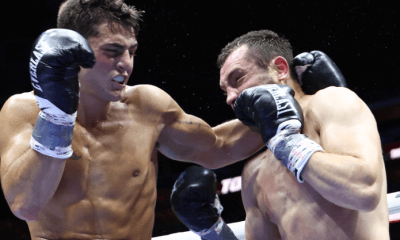
 Featured Articles2 weeks ago
Featured Articles2 weeks agoVito Mielnicki Jr Whitewashes Kamil Gardzielik Before the Home Folks in Newark
-
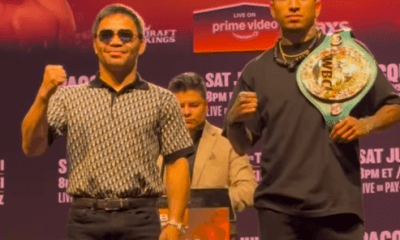
 Featured Articles4 weeks ago
Featured Articles4 weeks agoAvila Perspective, Chap 329: Pacquiao is Back, Fabio in England and More
-
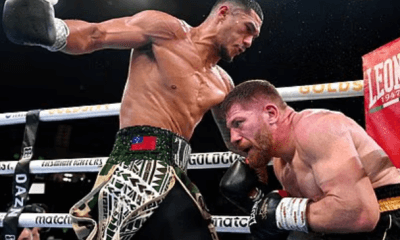
 Featured Articles3 weeks ago
Featured Articles3 weeks agoOpetaia and Nakatani Crush Overmatched Foes, Capping Off a Wild Boxing Weekend
-
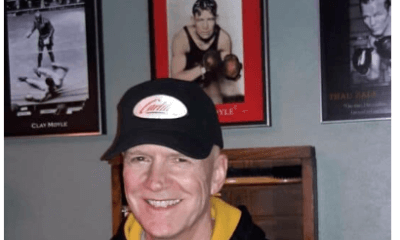
 Featured Articles2 weeks ago
Featured Articles2 weeks agoCatching Up with Clay Moyle Who Talks About His Massive Collection of Boxing Books
-

 Featured Articles4 weeks ago
Featured Articles4 weeks agoFabio Wardley Comes from Behind to KO Justis Huni
-
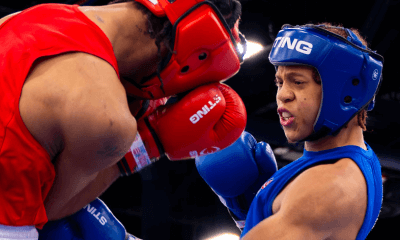
 Featured Articles1 week ago
Featured Articles1 week agoMore Medals for Hawaii’s Patricio Family at the USA Boxing Summer Festival
-
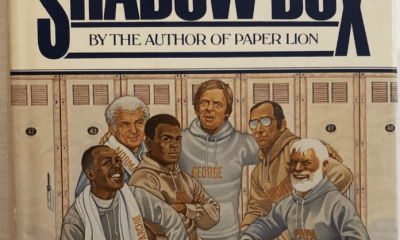
 Featured Articles4 weeks ago
Featured Articles4 weeks agoDelving into ‘Hoopla’ with Notes on Books by George Plimpton and Joyce Carol Oates















